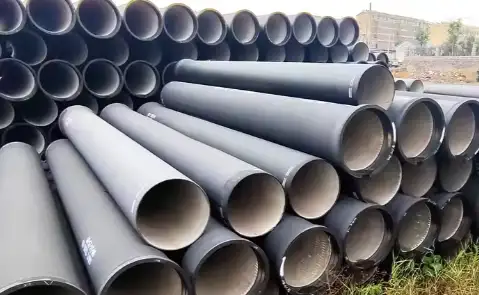Ductile iron pipes (DIP) are a cornerstone of modern water and wastewater infrastructure due to their durability, corrosion resistance, and ease of installation. A common question from engineers and contractors is: How long is 5 ductile iron pipes together? This article provides a comprehensive breakdown of ductile iron pipe lengths, joint systems, installation variables, and practical calculations to ensure accurate project planning.

Standard Lengths of Ductile Iron Pipes
Ductile iron pipes are manufactured in standardized lengths to streamline transportation and installation. The nominal length of a single pipe typically ranges from 5.5 meters (18 feet) to 6.1 meters (20 feet), depending on regional standards and diameter.
Key Standards by Region:
-
North America: AWWA C151 (18–20 feet per pipe).
-
Europe: EN 545 (5.5–6 meters per pipe).
-
Asia: ISO 2531 (varies by country).
Calculating Total Length of 5 Ductile Iron Pipes
To determine the combined length of 5 pipes, you must account for:
-
Individual Pipe Length
-
Joint Type and Engagement
-
Installation Tolerances
Formula:
Total Length = (Number of Pipes × Nominal Pipe Length) – (Number of Joints × Joint Engagement)
Joint Systems and Their Impact on Total Length
Ductile iron pipes use mechanical joints (MJ), push-on joints, or flanged joints. Each joint type consumes a portion of the pipe length during assembly.
Comparison of Joint Engagement:
| Joint Type | Engagement Length (mm) | Ease of Installation | Leak Resistance |
|---|---|---|---|
| Push-On Joint | 75–150 | High | Moderate |
| Mechanical Joint | 100–200 | Moderate | High |
| Flanged Joint | 200–300 | Low | Very High |
Example:
For five 6-meter pipes with push-on joints (100 mm engagement):
Total Length = (5 × 6,000 mm) – (4 × 100 mm) = 30,000 – 400 = 29,600 mm (29.6 meters).
Factors Affecting Installed Pipe Length
1. Thermal Expansion
Ductile iron expands at 10.8 µm/m·°C. Temperature swings (e.g., 30°C delta) add ~3.24 mm per 10 meters.
2. Trench Conditions
Uneven bedding or misalignment forces adjustments, reducing effective length.
3. Deflection Angles
Bends or directional changes require extra space between pipes.
Applications Requiring Precise Pipe Lengths
-
Municipal Water Mains:
-
Accurate lengths prevent leakage at joints.
-
-
Industrial Pipelines:
-
Thermal expansion loops demand precise spacing.
-
-
Underground Drainage:
-
Slope consistency relies on correct pipe alignment.
-
6 Common Questions About Ductile Iron Pipe Lengths
1. Why Do Joints Reduce the Total Length of Connected Pipes?
Joints require overlapping pipe ends to form a seal. For push-on joints, the spigot (male end) inserts into the bell (female end), consuming 75–150 mm per connection. This overlap ensures pressure integrity but shortens the overall span.
Calculation Example:
Five 6-meter pipes with MJ joints (150 mm engagement):
Total Length = (5 × 6,000) – (4 × 150) = 30,000 – 600 = 29,400 mm (29.4 meters).
2. Can I Use Shorter Pipes to Minimize Joint Engagement Loss?
Yes, but shorter pipes increase joint count, raising installation costs and leakage risks. For example, ten 3-meter pipes would lose 9 × 150 mm = 1,350 mm (1.35 meters) to joints, resulting in 28.65 meters—shorter than using five 6-meter pipes.
3. How Does Pipe Diameter Affect Total Length?
Larger-diameter pipes (≥600 mm) often have thicker walls and heavier joints, increasing engagement length. A 24-inch (600 mm) MJ joint may engage 200 mm vs. 150 mm for a 12-inch pipe.
AWWA C150 Engagement Guidelines:
| Pipe Diameter (mm) | Push-On Joint Engagement (mm) | Mechanical Joint Engagement (mm) |
|---|---|---|
| 100–300 | 75–100 | 100–150 |
| 350–600 | 100–125 | 150–200 |
| 600–1200 | 125–150 | 200–250 |
4. What Are the Tolerances for Pipe Lengths?
Manufacturing tolerances per AWWA C151 allow ±1% deviation. A nominal 6-meter pipe could range from 5.94 to 6.06 meters. For five pipes, cumulative tolerance may reach ±0.3 meters.
5. How to Compensate for Thermal Expansion in Long Pipelines?
Install expansion joints or loops every 50–100 meters. For ductile iron, the formula for expansion is:
ΔL = α × L × ΔT
Where:
-
α = 10.8 × 10⁻⁶ m/m·°C
-
L = Pipeline length
-
ΔT = Temperature change
Case Study:
A 100-meter pipeline in a desert (ΔT = 50°C) expands by:
ΔL = 10.8e⁻⁶ × 100 × 50 = 0.054 meters (54 mm).
6. Are There Software Tools for Pipe Length Calculations?
Yes, BIM software (e.g., AutoCAD Civil 3D) and pipeline calculators (e.g., Pressure Pipe Toolkit) automate length adjustments for joints, bends, and thermal effects.
Video Resource: Installing Ductile Iron Pipes
For a step-by-step installation guide, watch:
Conclusion
The total length of 5 ductile iron pipes typically ranges from 29 to 30 meters, depending on joint engagement and installation variables. By understanding joint systems, thermal dynamics, and industry standards, engineers can optimize pipeline layouts for cost and performance.
